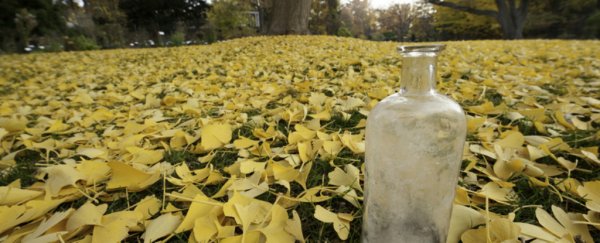In 1879, a botanist called William Beal buried 20 glass bottles in a secret spot on the grounds of Michigan State University. Each one was filled with sand and more than 1,000 seeds, and was angled with their uncorked mouths slanted downwards, so that water couldn't collect in them.
Four years from now, botanist Frank Teleweski will sneak out to that same location under the cover of darkness - just as many botanists have done before him - to dig up one of the bottles and test which of its seeds are still viable. After 137 years, there are now only five bottles left, in what has become the world's longest continuous experiment on seed germination.
According to Beal's original vision, the experiment was never meant to go on this long. He initially planned for the bottles to be removed every five years, with the entire process taking a century. But botanists at the WJ Beal Botanical Garden decided to extend the experiment, seeing as the results they were getting suggested that the seeds were lasting a lot longer than originally predicted - first to every 10, and now every 20 years.
If the experiment stays on track, the last seed pod will be unearthed in 2100 - 221 years after Beal first started it, and probably long after most of us have passed away.
While the experiment may sound simple, it's proven surprisingly effective. The original goal was to try to figure out one of the biggest problems for farmers - how the hell to get rid of weeds. This was before the days of pesticides, and farmers were finding that no matter how many weeds they removed, the same pests kept growing back in their fields.
Beal knew that this was because seeds were able to stay dormant in soil, and then grow back when conditions swung in their favour. But what he wasn't sure of was how long seeds could remain in that state. And just like that, the bottle experiment was born.
In an attempt to figure this out, Beal took 20 clear glass bottles, and filled each one with a mix of sand and 50 of 21 different common plants - a total of 1,050 seeds per bottle. He buried them 50 cm (20 inches) deep "on a sandy knoll in a row running east and west", marked their location on a map, and then left them alone for five years.
After each bottle was dug up, the seeds were planted to see which ones would grow. And for a good 40 years, that was most of them.
In 1920, a decade after Beal retired, his replacement noticed that the experiment was stabilising, with the same seeds sprouting each time, so he decided to wait 10 years before digging up the next bottle.
That worked okay for a while, but in 1980 only three species germinated, and the researchers decided to stretch the intervals out even further, to put more pressure on the seeds.
The last bottle was unearthed by Telewski in 2000, and there appears to be a clear winner in the longevity stakes already - a weed called moth mullein (Verbascum blattaria). In the latest planting, an impressive 23 of the plant's 50 seeds sprouted. "It is the only plant to consistently germinate in all of the tests. It will be very interesting to see if the seeds will still germinate 20 years from now," Telewski told Cara Giaimo over at Altas Obscura.
The only other plant that grew in this latest round was one seed from herb species Malva (now known as Malva pusilla). The other 19 plant species were unresponsive.
The knowledge gained from this research isn't just useful for people interested in getting rid of weeds (although, to be fair, we're not sure how useful it is to know that certain weed species can lie dormant in soil for more than a century) - it's also providing valuable insight to conservationists, who hope that in the future they might be able to regrow extinct plants from old seeds.
It's already known that seeds can stay viable for an incredibly long time if they're kept cold, without water or sunlight - back in 2005, Israeli researchers were able to grow a healthy date palm out of a well-preserved 2,000-year-old seed, and it's since gone on to have tree babies of its own.
In fact, that's the idea behind the seed-filled 'Doomsday Vault' built into the permafrost in the Arctic Circle, which is hoped will help re-harvest Earth after a global catastrophe.
But the preservation process isn't so well understood for seeds kept in ambient conditions, such as the ones in Beal's experiment, and so botanists are watching closely.
Telewski himself is incredibly excited to remove bottle number 16 in 2020. "In 1980, I was a graduate student in plant physiology, and we learned about the experiment … I had absolutely no idea that I would ever be the person to dig up the next bottle," he told Atlas Obscura. "And lo and behold, 20 years later, there I was … I have this wonderful opportunity to continue this historically important and significant experiment."
But for now, there's no way he's going to give up the location of the final five bottles until he has to hand his map on to the next curator of the garden.
"We don't advertise where they're buried because we don't want anybody poking around and digging up souvenirs," he said. "I'm always a little nervous when there's construction on campus. You know: 'Don't put a building there!' 'Why not?' 'I can't tell you, just don't!'"
Beal would be so proud.
